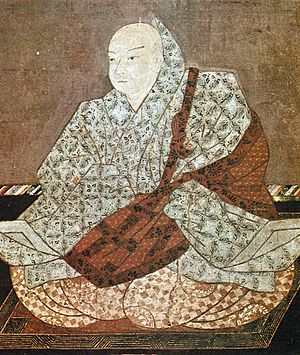Emperor Toba facts for kids
Quick facts for kids Emperor Toba鳥羽天皇 |
|||||
|---|---|---|---|---|---|
 |
|||||
| Emperor of Japan | |||||
| Reign | August 9, 1107 – February 25, 1123 | ||||
| Coronation | January 15, 1108 | ||||
| Predecessor | Horikawa | ||||
| Successor | Sutoku | ||||
| Born | February 24, 1103 | ||||
| Died | July 20, 1156 (aged 53) | ||||
| Burial | Anrakuju-in no misasagi (Kyoto) | ||||
| Spouse |
|
||||
| Issue Among others... |
|
||||
|
|||||
| House | Yamato | ||||
| Father | Emperor Horikawa | ||||
| Mother | Fujiwara no Ishi | ||||
Emperor Toba (鳥羽天皇, Toba-tennō, February 24, 1103 – July 20, 1156) was the 74th Emperor of Japan. He followed the traditional order of succession.
Emperor Toba ruled Japan from 1107 to 1123. He was an important figure in Japanese history. He later became a "cloistered emperor," meaning he ruled from behind the scenes.
Contents
Family and Early Life
Before he became emperor, his personal name was Munehito-shinnō. He was the son of Emperor Horikawa. His mother was Empress Dowager Fujiwara no Ishi.
When his mother passed away, his grandfather, the former Emperor Shirakawa, took care of him. Shirakawa raised Toba and guided him.
Emperor Toba had three main empresses and many children. Some of his children later became emperors themselves.
- Empress Fujiwara no Tamako:
- Imperial Prince Akihito, who became Emperor Sutoku.
- Imperial Princess Muneko, who became a priestess at Kamo Shrine.
- Imperial Prince Masahito, who became Emperor Go-Shirakawa.
- Empress Fujiwara no Nariko:
- Imperial Prince Narihito, who became Emperor Konoe.
- Imperial Princess Yoshiko, who became an empress to Emperor Nijō.
Key Events in Toba's Life
Emperor Toba's life was full of important changes and power shifts.
Becoming Emperor
On August 9, 1107, Emperor Horikawa died. His only son, Munehito, became the new emperor. He was only 4 years old at the time. This is when he became known as Emperor Toba.
Cloistered Rule
For the first few years of Toba's reign, his grandfather, the "retired" Emperor Shirakawa, held the real power. This way of ruling was called cloistered rule. It meant the retired emperor made all the big decisions.
On February 25, 1123, Emperor Toba's grandfather, Shirakawa, made him step down from the throne. Toba was only 20 years old. He had been emperor for 16 years. His son, Akihito, then became Emperor Sutoku. After stepping down, Toba took the title Daijō-tennō, which means "retired emperor."
Toba as Cloistered Emperor
In 1129, his grandfather, the retired Emperor Shirakawa, died. After this, Toba himself began to rule as a cloistered emperor. He held power for a long time, even though three different emperors officially sat on the throne: Emperor Sutoku, Emperor Konoe, and Emperor Go-Shirakawa. This shows how much influence Toba had.
In 1134, the former Emperor Toba went on a special trip. He made a pilgrimage to the Kumano Shrines, which are important religious sites.
Eras During Toba's Reign
In Japan, years are grouped into special periods called era names or nengō. Here are the eras that happened during Emperor Toba's time as emperor:
- Kajō (1106–1108)
- Tennin (1108–1110)
- Ten-ei (1110–1113)
- Eikyū (1113–1118)
- Gen'ei (1118–1120)
- Hōan (1120–1124)
See also
 In Spanish: Toba Tennō para niños
In Spanish: Toba Tennō para niños
- Emperor of Japan
- List of Emperors of Japan
- Imperial cult
- Emperor Go-Toba

